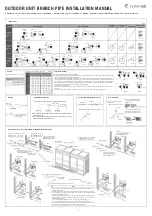
15
they rotate freely. Check for bolts and screws that may
have jarred loose during shipment to the job site. Re-
tighten if necessary. Re-tighten all electrical connections.
f
IEld
d
Uct
c
onnEctIonS
Verify that all duct connections are tight and that there is no
air bypass between supply and return.
P
RE
-
StaRtUP
P
REcaUtIonS
It is important to your safety that the unit has been properly
grounded during installation. Check ground lug connection
in main control box for tightness prior to closing circuit
breaker or disconnect switch. Verify that supply voltage
on line side of disconnect agrees with voltage on unit
identification plate and is within the utilization voltage
range as indicated in Appendix B Electrical Data.
System Voltage -
That nominal voltage value assigned
to a circuit or system for the purpose of designating its
voltage class.
Nameplate Voltage -
That voltage assigned to a piece of
equipment for the purpose of designating its voltage class
and for the purpose of defining the minimum and maximum
voltage at which the equipment will operate.
Utilization Voltage -
The voltage of the line terminals
of the equipment at which the equipment must give fully
satisfactory performance. Once it is established that supply
voltage will be maintained within the utilization range under
all system conditions, check and calculate if an unbalanced
condition exists between phases. Calculate percent voltage
unbalance as follows.
AIR FLOW ADJUSTMENTS
When the final adjustments are complete, the current
draw of the motor should be checked and compared to
the full load current rating of the motor. The amperage
must not exceed the service factor stamped on the motor
nameplate. The total airflow must not be less than that
required for operation of the furnace.
If an economizer is installed, check the unit operating
balance with the economizer at full outside air and at
minimum outside air.
notE: n
EvER
RUn
HIGH
StaGE
cfM
bEloW
300 cfM
PER
ton
EvaPoRatoR
fREEZInG
oR
PooR
UnIt
PERfoRMancE
IS
PoSSIblE
.
EEM - S
tandaRd
S
tatIc
d
RIvE
M
otoR
Adjust the CFM for the unit by changing the position of
the low voltage leads on the terminal block TB1. Refer to
Appendix A for blower performance at each speed tap.
Refer to Appendix D for maximum and minimum allowed
airflow for heating and cooling.
notE: I
f
MoRE
tHan
onE
lEad
IS
EnERGIZEd
SIMUltanEoUSly
,
tHE
MotoR
WIll
RUn
at
tHE
HIGHER
SPEEd
.
Fan speed for G (Fan), Y1 (Low Cool) are fixed setting on
TB1/T1 and cannot be moved.
Fan speed for W1 (Low Heat) is fixed setting on TB1/T2
and cannot be moved.
Purple wire Y2 (High Cool) and Brown wire W2 (High Heat)
are connected to TB1/T3. These wires can be moved
together or separately and placed on unoccupied terminal
T4 or T5.
n
otE
:
foR
PRoPER
oPERatIon
y2
and
W2
SHoUld
HavE
a
HIGHER
SPEEd
SEttInG
tHan
tHE
G, y1
and
W1
SPEEd
SEttInG
.
For gas heat units, the airflow must be adjusted so that the
air temperature rise falls within the ranges given stated on
Data Plate.
E
lEctRIcal
I
nPUt
c
HEck
Make preliminary check of evaporator fan ampere draw
and verify that motor nameplate amps are not exceeded. A
final check of amp draw should be made upon completion
of air balancing of the duct system (see Appendix B).
GAS SYSTEM CHECK
P
RE
-o
PERatIon
c
HEckS
1. Close the manual gas valve external to the unit.
2. Turn off the electrical power supply to the unit.
3. Change heating setpoint to its lowest possible setting.
4. Remove the heat exchanger door on the side of the
unit by removing screws.
5. This unit is equipped with an ignition device which
automatically lights the main burner. DO NOT try to
light burner by any other method.
6. Move the gas control valve switch to the OFF position.
7.
Wait five minutes to clear out any gas.
8. Smell for gas, including near the ground. This is
important because some types of gas are heavier
than air. If you have waited five minutes and you do
smell gas, immediately follow the warning WHAT TO
DO IF YOU SMELL GAS on page 2 of this manual.
If having waited for five minutes and no gas smell is
noted, move the gas control valve switch to the ON
position.
9. Replace the heat exchanger door on the side of the
unit.
10. Open the manual gas valve external to the unit.
11. Turn on the electrical power supply to the unit.
12. Change heating setpoint to desired setting.
















































